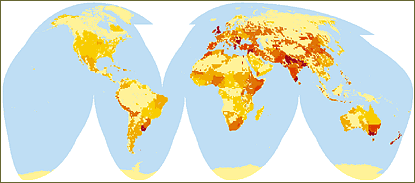- Leave the mozzarella. Take the lard.
- Great post, great paper on mobile phones and the price of fish. Via.
- Rice distribution maps, current and historical.
Follow your tree in Google Earth
I agree with Frank Taylor at Google Earth Blog: it is a really good idea. You go to mybabytree.org, pay $5.50, and WWF plants a tree (you have a choice of 3 species) for you in Sebangau National Forest in Kalimantan, Indonesia, and sends you a KML file of its location. How about doing the same for heirloom varieties of fruit trees or something?
Disease hotspots mapped
A letter in Nature this week looks at “Global trends in emerging infectious diseases.” ((Kate E. Jones, Nikkita G. Patel, Marc A. Levy, Adam Storeygard, Deborah Balk, John L. Gittleman & Peter Daszak. Nature 451, 990-993 (21 February 2008); doi:10.1038/nature06536.)) It includes some interesting maps, including these:

They show the global distribution of relative risk of an emerging infectious disease (EID) event caused by: (a) zoonotic pathogens from wildlife, (b) zoonotic pathogens from non-wildlife, (c) drug-resistant pathogens and (d) vector-borne pathogens. That’s based on climate, human population density and growth, and wildlife host species richness. Note in particular the map in the top right-hand corner: basically risk of zoonotic pathogens jumping to humans from livestock. Compare this livestock density ((FAO has more data on this.)):

Not a great match with density of domesticated animals. Maybe the correlation would be better with livestock diversity?
A modest proposal
That last but one post of Jeremy’s got me thinking. How do we find out if Arachis ipaensis is still at that locality? I mean, short of mounting a fully-fledged expedition of groundnut experts at vast expense, that is. One way might be to ask a local person to check for us. Ok, a wild peanut species might not be the best thing to try this with, but you get the idea. Problem is, how do we identify a local person who knows that area?
Then I remembered something Jeremy sent me recently. WikiLoc is a website to which you can upload your favourite walk or cycle ride as a GPS track. You can then view all these in a number of different ways, including in Google Earth. So I gbiffed (sensu Cherfas, 2008) the localities of wild Arachis species and viewed them in Google Earth together with all the tracks from South America available on WikiLoc.
Well, of course, none of the trails was anywhere near the locality of A. ipaensis. But I did find others that came near — or very near — the localities of other species. Check this one out, for example:
It’s a 32 km circuit around Piribebuy in Paraguay, and it was uploaded by someone called Yagua. It takes about 4 hours to walk it. And it so happens that a specimen of Arachis glabrata was collected along Yagua’s favourite trail, around its southeastern corner:

Now, I don’t think A. glabrata is a particularly significant component of the groundnut genepool, but say, for the sake of argument, that it had been. Couldn’t we ask Yagua to keep an eye on it for us? Multiply by the more than 10,000 tracks on WikiLoc and pretty soon you’re talking about a real global network of agrobiodiversity monitors. But maybe we should test the idea out with a somewhat more — ahem — charismatic plant. And imagine if germplasm collectors start adding their tracks to WikiLoc.
Rice maps
I’ve linked on a couple of occasions to Robert Hijmans’ rice maps, as published in IRRI’s Rice Today magazine. Robert has now put these all together on a single webpage. Good idea.